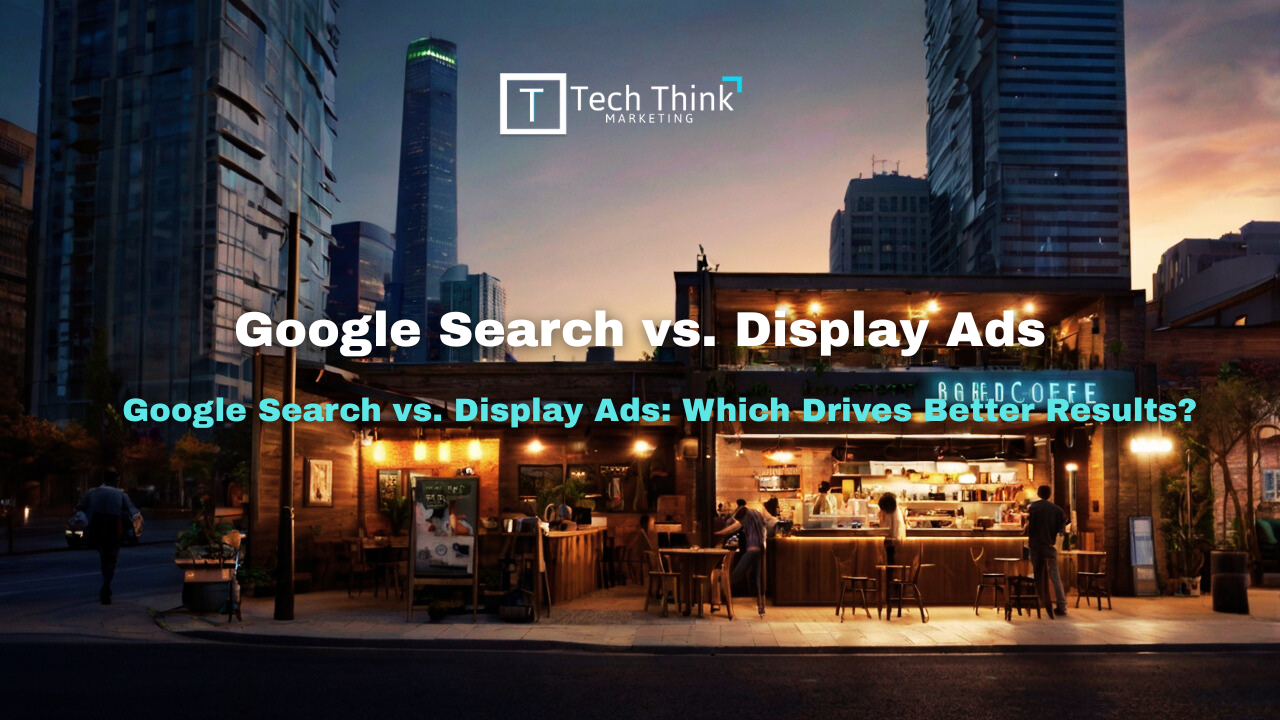Office No. 608, Lunkad Sky Station, Viman Nagar Road, Pune, Maharashtra 411014, India
Phone: +1 213-261-0597
contact@techthinkmarketing.com
Table of Contents
ToggleIntroduction
Google Search vs. Display Ads When it comes to Google Ads, advertisers have two main networks to choose from: Search and Display. Both offer powerful opportunities to reach customers, but they work very differently—and deliver different results depending on your goals.
If you’re wondering which one is right for your business, you’re in the right place. In this article, we’ll break down the differences, strengths, and best uses of search vs. display ads so you can make an informed decision for your next campaign.
1. Understanding Google Search Ads
Google Search vs. Display Ads Google Search Ads appear at the top (and sometimes bottom) of Google’s search results when people actively type in a query.
Example: If someone searches for “best running shoes for women,” they may see search ads from sports retailers at the top of the page.
Key Characteristics:
-
- Intent-based: Search Ads target people already looking for what you offer.
-
- Text-focused: No images—just headlines, descriptions, and links.
-
- Pay-per-click (PPC): You pay only when someone clicks your ad.
Advantages of Search Ads:
-
- High Intent—You’re reaching people already interested in buying.
-
- Precise Targeting – Choose exact keywords and match types.
-
- Quick Results – Can drive leads or sales almost immediately.
Drawbacks:
-
- Highly competitive keywords can be expensive.
-
- Limited space for creativity (mostly text).
2. Understanding Google Display Ads
Google Search vs. Display Ads Google screens appear on millions of websites, apps, and YouTube videos that are part of the Google Display Network (GDN).
Example: Google Search vs. Display Ads When you read a blog about travel tips, you can see a banner ad for flight tickets.
Main features:
Visual-based: Use photos, videos, and animations.
-
- Extensive access: You can target the interests of the public, demographics, or browsing.
-
- Brand awareness: Ideal for reaching people first in buying travel.
-
- The benefits of performance ads:
-
- Large-scale access—more than 90% of Internet users worldwide.
-
- Creative flexibility—pictures, videos, and animations.
-
- CPC is cheaper than cost-effective advertising ads.
-
- Missing:
-
- Low intentions—many people are not actively seeking for your proposal.
If targeting is very wide, then there is more risk of wasted clicks.
3. Search vs. Display: Key Differences at a Glance
| Feature | Search Ads | Display Ads |
|---|---|---|
| Ad Type | Text-based | Image/video-based |
| User Intent | High | Medium to low |
| Reach | Smaller, targeted audience | Wide, broad audience |
| Best For | Direct conversions | Brand awareness, remarketing |
| Cost per Click | Higher | Lower |
| Speed to Results | Fast | Slower |
4. When to Use Search Ads
Google Search vs. Display Ads When search ads are best:
You want direct sales or to go fast.
-
- The audience actively searches for your product/service.
-
- You have a limited budget and require targeted results.
Example:
-
- A locksmith targets “Emergency Lockout Service.”
An online course provider is aimed at “Learning Online Coding.”
5. When to Use Display Ads
Result ads are the best:Google Search vs. Display Ads
-
- You want to create brand awareness.
-
- You target wide target groups for a new product.
-
- You run a remarketing campaign to get back visitors.
-
- A fabric mark shows its new summer collection.
A travel company retreats visitors who watched the holiday packages.
6. Combining Search and Display for Maximum Impact
This is the truth—Google Search vs. Display Ads you don’t always have to choose one. Many successful advertisers use both discovery and performance at the same time.
Example strategy:
-
- Use search ads to catch high entrants.
-
- Use performance ads for remarketing—ads for those who went to your site but did not change.
This two-Google Search vs. Display Ads stage approach ensures that you get brand conversion from those prepared to create users while maintaining your brand to make decisions.
7. Measuring Success: What to Track
For search ads:
-
- Click Frequency (CTR)
-
- conversion rate
-
- Per conversion cost
-
- Quality point
-
- For performance advertisement:
-
- Raid
-
- Engagement speed (click, video scene)
Transparent conversion (those who saw your advertisement and later converted)
8. Real-Life Example: Local Restaurant Campaign
A small restaurant wanted to increase weekday lunch orders.
-
- They used Search Ads targeting “lunch deals near me” and got a steady stream of customers searching for lunch options.
-
- They also ran display ads with tempting food images on local news sites, retargeting people who had visited their menu page.
Result: Search Ads drove immediate sales, while Display Ads increased brand recognition and boosted future visits.
Conclusion
So—which drives better results: search or display ads?
The answer depends on your goals.Google Search vs. Display Ads If you want quick, high-intent conversions, Search Ads are your best bet. If you want to reach a wider audience and build brand awareness, display ads shine.
For many businesses, a smart combination of both networks delivers the best long-term ROI. The key is to test, track results, and adjust your strategy to match your audience’s behavior.





